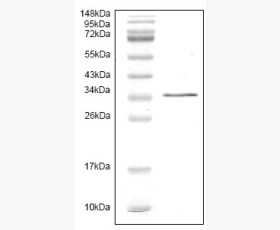Recombinant Human Tumor Necrosis Factor Receptor II/TNFRSF1B/CD120b
| Product name: | Recombinant Human Tumor Necrosis Factor Receptor II/TNFRSF1B/CD120b |
| Source: | Human Cells |
| Purity: | Greater than 95% as determined by reducing SDS-PAGE. |
| Buffer Formulation: | Lyophilized from a 0.2 μm filtered solution of PBS, pH7.4. |
| Applications: | Applications:SDS-PAGE; WB; ELISA; IP. |
| Storage: | Avoid repeated freeze/thaw cycles. Store at 2-8 oC for one month. Aliquot and store at -80 oC for 12 months. |
| UOM: | 100ug/50ug/200ug/1mg/1g |
| Source | Human Cells |
| Description | Recombinant Human Tumor Necrosis Factor Receptor II is produced by our expression system and the target gene encoding Leu23-Asp257 is expressed with a Fc tag at the C-terminus. |
| Names | Tumor necrosis factor receptor superfamily member 1B, TNFRSF1B, Tumor necrosis factor receptor 2, TNF-R2, TNF-RII, Tumor necrosis factor receptor type II, p75, p80 TNF-alpha receptor, CD120b |
| Accession # | P20333 |
| Formulation | Lyophilized from a 0.2 μm filtered solution of PBS, pH7.4. |
| Shipping |
The product is shipped at ambient temperature. |
| Reconstitution |
Always centrifuge tubes before opening. Do not mix by vortex or pipetting. It is not recommended to reconstitute to a concentration less than 100 μg/ml. Dissolve the lyophilized protein in ddH4O. Please aliquot the reconstituted solution toPTTLGTIHSPEDVIKALADHHHHHHHHHE |
| Storage |
Lyophilized protein should be stored at < -20°C, though stable at room temperature for 3 weeks. Reconstituted protein solution can be stored at 4-7°C for 2-7 days. Aliquots of reconstituted samples are stable at < -20°C for 3 months. |
| Purity |
Greater than 95% as determined by reducing SDS-PAGE. |
| Endotoxin | Less than 0.1 ng/µg (1 IEU/µg) as determined by LAL test. |
| Amino Acid Sequence |
LPAQVAFTPYAPEPGSTCRLREYYDQTAQMCCSKCSPGQHAKVFCTKTSDTVCDSCEDSTYTQLW NWVPECLSCGSRCSSDQVETQACTREQNRICTCRPGWYCALSKQEGCRLCAPLRKCRPGFGVARP GTETSDVVCKPCAPGTFSNTTSSTDICRPHQICNVVAIPGNASMDAVCTSTSPTRSMAPGAVHLP QPVSTRSQHTQPTPEPSTAPSTSFLLPMGPSPPAEGSTGDIEGRDMDPKSCDKTHTCPPCPAPEL LGGPSVFLFPPKPKDTLMISRTPEVTCVVVDVSHEDPEVKFNWYVDGVEVHNAKTKPREEQYNST YRVVSVLTVLHQDWLNGKEYKCKVSNKALPAPIEKTISKAKGQPREPQVYTLPPSRDELTKNQVS LTCLVKGFYPSDIAVEWESNGQPENNYKTTPPVLDSDGSFFLYSKLTVDKSRWQQGNVFSCSVMH EALHNHYTQKSLSLSPGK
|
| Background | Tumor necrosis factor receptor superfamily member 1B (TNFRSF1B) is a member of the tumor necrosis factor receptor superfamily. Human TNF RII contains four cysteinerich repeats in its ECD, which shares 58% and 56% amino acid sequence identity with the mouse and rat orthologs, respectively.TNF RII is expressed predominantly on cells of the hematopoietic lineage, such as T and natural killer cells, as well as on endothelial cells, microglia, astrocytes,neurons, oligodendrocytes, cardiac myocytes, thymocytes, and mesenchymal stem cells.TNF RII binds to the membranebound forms of TNFα and Lymphotoxinα/TNFβ;soluble TNF is thought to signal predominately through TNF RI.Soluble TNF RII is believed to inhibit TNF biological activity by binding TNF thereby preventing it from activating membrane TNF receptors. |














